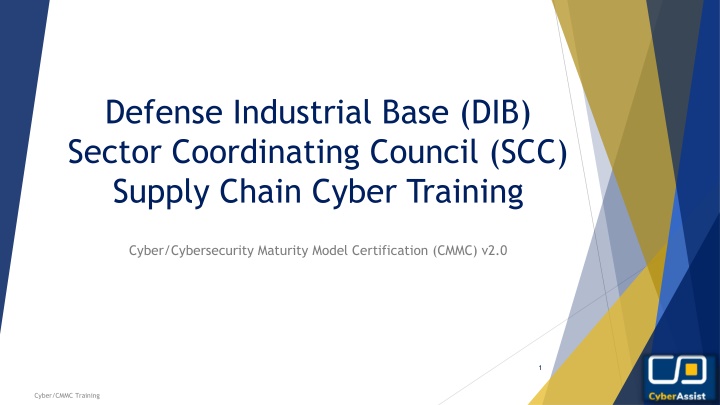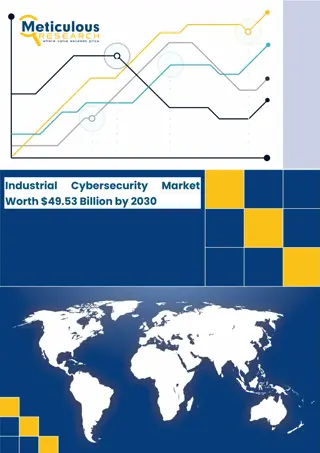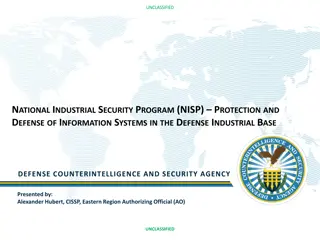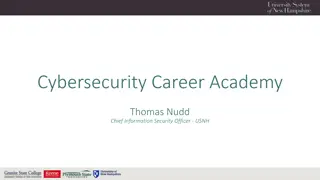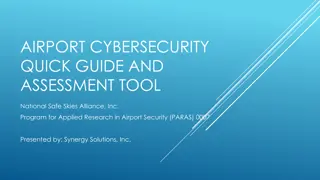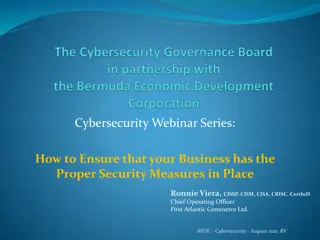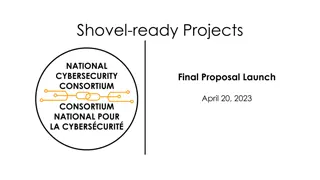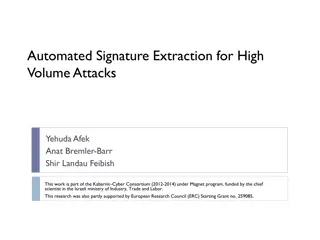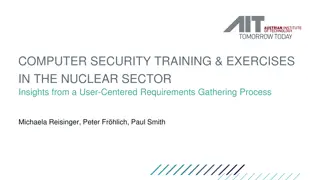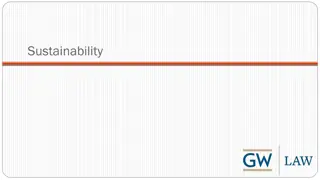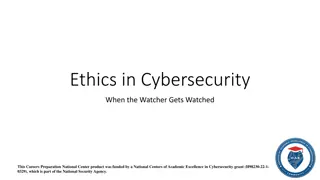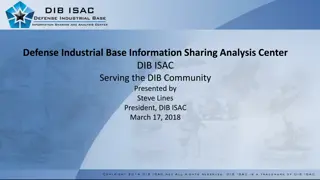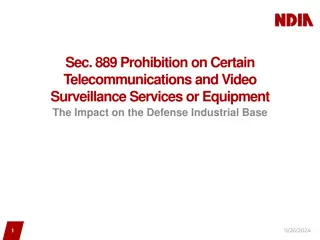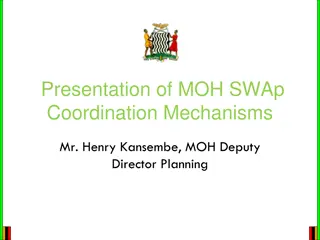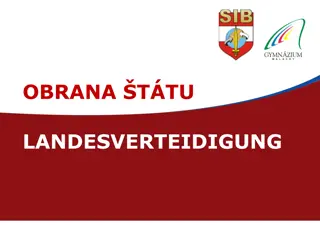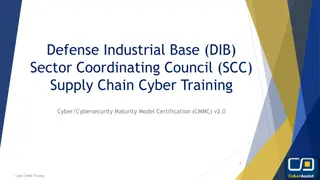Defense Industrial Base Sector Coordination for Cybersecurity
Dive into the realm of Defense Industrial Base Sector Coordination to stay updated on Cybersecurity Maturity Model Certification (CMMC) requirements, incident reporting, and best practices. Get informed about the critical components of CMMC, including protecting U.S. Government information, CMMC domains, and the self-assessment process. Equip yourself with essential knowledge to prepare your organization for CMMC compliance.
Download Presentation

Please find below an Image/Link to download the presentation.
The content on the website is provided AS IS for your information and personal use only. It may not be sold, licensed, or shared on other websites without obtaining consent from the author.If you encounter any issues during the download, it is possible that the publisher has removed the file from their server.
You are allowed to download the files provided on this website for personal or commercial use, subject to the condition that they are used lawfully. All files are the property of their respective owners.
The content on the website is provided AS IS for your information and personal use only. It may not be sold, licensed, or shared on other websites without obtaining consent from the author.
E N D
Presentation Transcript
Defense Industrial Base (DIB) Sector Coordinating Council (SCC) Supply Chain Cyber Training Cyber/Cybersecurity Maturity Model Certification (CMMC) v2.0 1 Cyber/CMMC Training
Agenda Module 1: Cybersecurity: Why it is Important? Module 2: Cybersecurity Maturity Model Certification Module 3: Incident Reporting Module 4: Cybersecurity Best Practices Resource Guide: Glossary, Acronym Guide and Resources for Additional Information CMMC Domains Survey 2 Cyber/CMMC Training
Cybersecurity Maturity Model Certification (CMMC) Level 1 Module 2 3 Cyber/CMMC Training
Note: CMMC is still going through the rule- making process and certain aspects and requirements may change. Refer to the Resources Guide provided in this training for the most updated information. Disclaimer and Overview The intent of this training is to build awareness for Defense Industrial Base (DIB) suppliers of the likely requirements of the Cybersecurity Maturity Model Certification (CMMC) and their obligation to meet FAR 52.204-21 (basic cyber hygiene) and DFARS 252.204-7012 (specialized data handling and protection requirements). This training is self-paced and intended for a range of roles and responsibilities including, but not limited to, executives, project managers and technical staff from organizations seeking certification (OSC) and need to comply with CMMC. Currently, CMMC does not apply to any contractor. Note: Completion of this training DOES NOT certify your organization. This training is intended for the purposes of providing awareness of the subjects outlined above. The DIB Sector Coordinating Council (SCC) Supply Chain Task Force does not take responsibility for suppliers certification by the CMMC 3rd Party Assessment Organization (C3PAO). This training focuses on U.S. regulations and industry best practices: U.S. Department of Defense (DoD) Chief Information Officer (CIO) Cybersecurity Maturity Model Certification (CMMC) Information National Institute of Standards & Technologies (NIST) publications National Archives & Records Administration (NARA) definitions DIB SCC Supply Chain Task Force CyberAssist website 4 Cyber/CMMC Training
Module Topics and Objectives Helpful Hint: Refer to the Resource Guide for a Glossary and Acronym Guide Topics covered in this module: Cybersecurity Maturity Model Certification (CMMC) Protecting U.S. Government Information: FCI and CUI CMMC Domains, CMMC Enumeration/Numbering Defined and Self-Assessment process How to Prepare for CMMC The objectives of this module are: Provide understanding of the CMMC model; Provide understanding of FCI and CUI; Provide understanding of the self-assessment process; and Provide guidance on how to prepare for CMMC. A legend has been provided to assist with determining the content that you will need to know for each of the CMMC levels and what is additional content that will assist your organization with your cybersecurity posture. The corresponding symbol will be located at the top left corner of the slide. Content Legend = CMMC L1 Content = CMMC L2 Content = CMMC L3 Content = Non-CMMC Content/Extra Cyber/CMMC Training 5
Cybersecurity Maturity Model Certification (CMMC) CMMC was created by the DoD in response to rising malicious cyber activity impacting Department of Defense (DoD) systems and data. CMMC measures the implementation of cybersecurity requirements at three levels. CMMC Model 2.0 combines various cybersecurity standards and best practices and is built on NIST 800- 171 and a sub-set of NIST 800- 172. 6 Source: Cybersecurity Maturity Model Certification Model Overview Version 2.0 | December 2021, https://dodcio.defense.gov/Portals/0/Documents/CMMC/ModelOverview_V2.0_FINAL2_20211202_508.pdf Cyber/CMMC Training
Protecting U.S. Government Information: FCI What is FCI? FCI is any U.S. Government information that is not intended for public release that is provided by or generated for the U.S. Government Key Regulation? FAR 52.204-21: Basic Safeguarding of Covered Contractor Information Systems Key Documents? None, 15 FAR controls map to 17 National Institute of Standards and Technology (NIST) Special Publication (SP) 800-171 controls CMMC Self-Assessment Guide - Level 1 7 Cyber/CMMC Training
Protecting U.S. Government Information: CUI What is CUI? CUI is Information that requires safeguarding or dissemination controls pursuant to and consistent with law, regulations, and government-wide policies, excluding information that is classified under Executive Order 13526, Classified National Security Information, December 29, 2009, or any predecessor or successor order, or the Atomic Energy Act of 1954, as amended. Source: E.O. 13556 (adapted) Key Regulation? DFARS 252.204-7012: Safeguarding Covered Defense Information (CDI) and Cyber Incident Reporting Note: This clause does not apply to contractors where it has been determined that CUI is not managed in the contractor's environment Key Documents? NISTSP 800-171 and NIST SP 800-171A NIST SP 800-172 and NIST SP 800-172A (CMMC Level 3) CMMC Assessment Guide - Level 2 For more information on the CUI categories, refer to the CUI Registry, http://www.archives.gov/cui/registry/category-list.html 8 Cyber/CMMC Training
The CMMC Model Domains, Practices and Self-Assessment Process 9
CMMC Domains CMMC Domains (14) Identification and Authentication (IA) Identification and Authentication (IA) Audit and Accountability (AU) Audit and Accountability (AU) Configuration Management (CM) Configuration Management (CM) Access Control (AC) Access Control (AC) Awareness and Training (AT) Awareness and Training (AT) Identification and Authentication (IA) Audit and Accountability (AU) Configuration Management (CM) Access Control (AC) Awareness and Training (AT) Identification and Authentication (IA) Audit and Accountability (AU) Configuration Management (CM) Identification and Authentication (IA) Incident Response (IR) Incident Response (IR) Maintenance (MA) Maintenance (MA) Media Protection (MP) Media Protection (MP) Personnel Security (PS) Personnel Security (PS) Physical Protection (PE) Physical Protection (PE) Incident Response (IR) Maintenance (MA) Media Protection (MP) Personnel Security (PS) Physical Protection (PE) System and Communications Protections (SC) System and Communications Protections (SC) System and Information Integrity (SI) System and Information Integrity (SI) Risk Assessment (RA) Risk Assessment (RA) Security Assessment (CA) Security Assessment (CA) System and Communications Protections (SC) System and Information Integrity (SI) Risk Assessment (RA) Security Assessment (CA) System and Communications Protections (SC) System and Information Integrity (SI) Legend: Green cells: Includes CMMC L1 practices Gray cells: Includes CMMC L2 or higher practices Note: The 6 CMMC domains highlighted in green are discussed in the following slides. For more information on the remaining 8 CMMC domains, refer to the Supporting Material section at the end of the training. 10 Cyber/CMMC Training
Access Control (AC) Access control is the process of granting or denying requests to use information, to use information processing services and/or enter company facilities. System- based access controls are called logical access controls, who or what (in the case of a process) is permitted to have access to a system resource and type of access permitted.* Do you securely log into your company systems? Does your company limit system access to types of transactions and functions? Does your company restrict access to company facilities? What is sensitive information? Do you know how to handle and protect sensitive information? 11 *https://www.acq.osd.mil/asda/dpc/cp/cyber/docs/safeguarding/DoD-Guidance-for-Reviewing- System-Security-Plans-and-the-NIST-SP-800-11-6-2018.pdf Cyber/CMMC Training
Identification and Authentication (IA) Identification and authentication is a technical measure that prevents unauthorized individuals or processes from entering a system. Identification and authentication is a critical building block of information security since it is the basis for most types of access control and for establishing user accountability.* How do users log into your systems? Does everyone have full administrative rights on all systems? Do you use any type of multifactor authentication (MFA)? Do you have any password requirements setup? Do you have a process for removing user accounts when an individual leaves the company? 12 *https://www.acq.osd.mil/asda/dpc/cp/cyber/docs/safeguarding/DoD-Guidance-for-Reviewing- System-Security-Plans-and-the-NIST-SP-800-11-6-2018.pdf Cyber/CMMC Training
Media Protection (MP) Media protection is a requirement that addresses the defense of system media, which can be described as both digital and nondigital. Media protections can restrict access and make media available to authorized personnel only, apply security labels to sensitive information, and provide instructions on how to remove information from media so that the information cannot be retrieved or reconstructed.* Do you sanitize systems before sending for disposal? Do you protect backups at off-site facilities? Do you protect your systems from removable media especially when coming from an unknown source? 13 *https://www.acq.osd.mil/asda/dpc/cp/cyber/docs/safeguarding/DoD-Guidance-for-Reviewing- System-Security-Plans-and-the-NIST-SP-800-11-6-2018.pdf Cyber/CMMC Training
Physical Protection (PE) The term physical (and environmental) security refers to measures taken to protect systems, buildings, and related supporting infrastructure against threats associated with their physical environment.* Do you track and monitor visitors? Is physical access to systems limited? Do you take security measures when working offsite? 14 *https://www.acq.osd.mil/asda/dpc/cp/cyber/docs/safeguarding/DoD-Guidance-for-Reviewing- System-Security-Plans-and-the-NIST-SP-800-11-6-2018.pdf Cyber/CMMC Training
System and Communications Protection (SC) System and communications protection requirements provide an array of safeguards for the system, including the confidentiality information at rest and in transit. System and communications protection also establishes boundaries that restrict access to publicly accessible information within a system. Using boundary protections, a company can monitor and control communications at external boundaries as well as key internal boundaries within the system.* Do you have firewalls and other segregation on your network? Do you segregate public-facing systems from internal only systems? Do you use encryption when transmitting over the Internet? Do you limit the ability to connect to systems from outside the company? 15 *https://www.acq.osd.mil/asda/dpc/cp/cyber/docs/safeguarding/DoD-Guidance-for-Reviewing- System-Security-Plans-and-the-NIST-SP-800-11-6-2018.pdf Cyber/CMMC Training
System and Information Integrity (SI) System and information integrity provides assurance that the information being accessed has not been meddled with or damaged by an error in the system.* Do you use Anti-malware/Anti-virus software and keep it updated? Do you monitor for system vulnerabilities and/or malicious attacks? 16 *https://www.acq.osd.mil/asda/dpc/cp/cyber/docs/safeguarding/DoD-Guidance-for-Reviewing- System-Security-Plans-and-the-NIST-SP-800-11-6-2018.pdf Cyber/CMMC Training
CMMC Enumeration/Numbering Defined Each practice is specified using the convention of DD.L#-REQ where: DD is the two-letter domain abbreviation; L# is the level number; and REQ is the NIST SP 800-171 Rev 2 or NIST SP 800-172 security requirement number. Example of the breakdown of a CMMC practice: - L1 3.1.1 AC . Description: Limit information system access to authorized users, processes acting on behalf of authorized users, or devices (including other information systems). 17 Source: Cybersecurity Maturity Model Certification Model Overview Version 2.0 | December 2021, https://dodcio.defense.gov/Portals/0/Documents/CMMC/ModelOverview_V2.0_FINAL2_20211202_508.pdf Cyber/CMMC Training
Identify Self-Assessment Scope Prior to conducting self-assessment, the scope needs to be identified, CMMC Self-Assessment Scope Level 1 Guide FCI Assets are part of the CMMC Self Assessment Scope and are assessed against applicable CMMC practices. Process - FCI can be used by an asset Store - FCI is inactive or at rest Transmit - FCI is being transferred from one asset to another asset Consider people, technology, facilities and external service provider (ESP) within the environment that process, store and transmit FCI 18 Source: Cybersecurity Maturity Model Certification Model Overview Version 2.0 | December 2021, https://dodcio.defense.gov/Portals/0/Documents/CMMC/Scope_Level1_V2.0_FINAL_20211202_508.pdf Cyber/CMMC Training
Self-Assessment Observation Activities Self-Assessors should become intimately familiar with the CMMC Self-Assessment Guide Level 1, and the Assessment Objectives associated with each practice Each practice will require the use of at least two assessment methods to validate assessment objectives to identify objective evidence. Assessment Objectives identify the specific list of objectives that must be satisfied to receive a rating of MET for the practice or process, which means your company has completed the objectives for that practice or process Assessment Methods define the nature and the extent of the assessor s actions Examine (Artifact) Interview (Observation/Affirmation) Test (Demonstrate) Assessment Objects identify the specific items being assessed and can include specifications, mechanisms, activities, and individuals Self-assessment of CMMC practice results in one of three possible findings: MET NOT MET NOT APPLICABLE All Level 1 practices will need a finding of MET or NOT APPLICABLE, to demonstrate CMMC Level 1 compliance 19 Source: Cybersecurity Maturity Model Certification Model Overview Version 2.0 | December 2021, https://dodcio.defense.gov/Portals/0/Documents/CMMC/AG_Level1_V2.0_FinalDraft_20211210_508.pdf Cyber/CMMC Training
Practice and Self-Assessment Objectives Example 20 Source: Cybersecurity Maturity Model Certification Model Overview Version 2.0 | December 2021, https://dodcio.defense.gov/Portals/0/Documents/CMMC/AG_Level1_V2.0_FinalDraft_20211210_508.pdf Cyber/CMMC Training
Potential Self-Assessment Methods and Objects for Practice Example Potential Objects 21 Source: Cybersecurity Maturity Model Certification Model Overview Version 2.0 | December 2021, https://dodcio.defense.gov/Portals/0/Documents/CMMC/AG_Level1_V2.0_FinalDraft_20211210_508.pdf Cyber/CMMC Training
CMMC Practice Interconnectivity The practices in CMMC are interconnected and work together to help provide good cyber hygiene. For example: CMMC Practice CMMC Practice IA.L1-3.5.1 IA.L1-3.5.1, identifies information system users, processes acting on behalf of users, or devices AC.L1-3.1.1 AC.L1-3.1.1, controls system access based on user, process or device identity AC.L1-3.1.1 leverages IA.L1-3.5.1 which provides a vetted and trusted identity for access control required by AC.L1-3.1.1. 22 Cyber/CMMC Training
How to Prepare for CMMC Level 1 Recommendations prior to contract award: Understand contract requirements: FAR 52.204-21, FCI and other applicable clauses and standards (Module 2) Be aware of contractual reporting requirements (Module 3) Keep performing cybersecurity best practices (Module 4) Perform your self-assessment: CMMC Self- Assessment Level 1 Guide and CMMC Level 1 practices (Module 2) This Photo by Unknown Author is licensed under CC BY-SA-NC Recommendations for after contract award: Keep self-assessment score up to date (annually) Monitor any changes to your environment Follow and maintain reporting requirements Be aware of flow down requirements for subcontractors Submit self-assessment per DoD guidance TBD Understand subcontractor compliance requirements and keep up to date with regulatory changes 23 Cyber/CMMC Training
Module Summary Understanding current and future regulatory requirements is imperative as a DoD supplier Specialized information types, such as FCI and CUI, must be handled and protected according to applicable requirements Understanding the CMMC model: Breaking down parts of the model for further understanding Providing steps to prepare for CMMC For questions on the content, please send them to DIB SCC Cyber Training. Next: Module 3 - Incident Reporting 24 Cyber/CMMC Training
